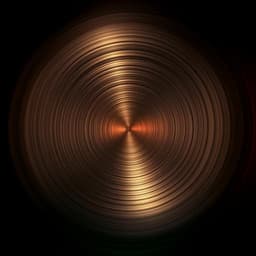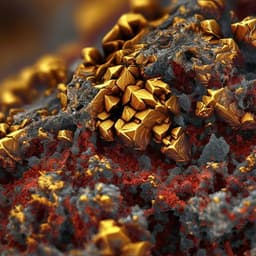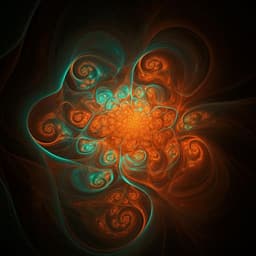
Physics
Discovery of ultrafast spontaneous spin switching in an antiferromagnet by femtosecond noise correlation spectroscopy
M. A. Weiss, A. Herbst, et al.
Discover how spontaneous picosecond spin switching can occur in antiferromagnets, driven by thermal fluctuations. This groundbreaking research by M. A. Weiss and team highlights enhanced magnon fluctuations and introduces a new mode in ultrafast spintronics. Explore the insights of this pioneering study on Sm<sub>0.7</sub>Er<sub>0.3</sub>FeO<sub>3</sub>.
~3 min • Beginner • English
Introduction
The study investigates spontaneous incoherent magnon fluctuations and their ultrafast dynamics in an antiferromagnet. Fluctuations fundamentally shape magnetic properties and phases, but in antiferromagnets the relevant magnon frequencies reach the sub-THz/THz regime, beyond the reach of conventional spin noise spectroscopy (SNS). Prior ultrafast pump–probe methods access femtosecond dynamics but perturb the system and cannot reveal thermal or quantum fluctuation-driven incoherent dynamics. The central question is whether antiferromagnetic spin systems undergo spontaneous picosecond-scale switching due to thermal fluctuations, and how such dynamics can be observed without external excitation. The authors propose and demonstrate a femtosecond noise correlation spectroscopy approach that measures the temporal autocorrelation of magnetization fluctuations via Faraday rotation noise to reveal sub-THz magnon dynamics in Sm0.7Er0.3FeO3 near the spin reorientation transition (SRT).
Literature Review
Traditional studies of incoherent spin fluctuations rely on temperature-dependent macroscopic observables (heat capacity, conductivity, magnetic susceptibility) or frequency-domain optical probes such as Raman scattering and diffraction. SNS has enabled MHz–GHz fluctuation measurements in paramagnets but is inadequate for correlated antiferromagnets with THz magnons. Ultrafast pump–probe spectroscopy accesses femto/attosecond dynamics in antiferromagnets but introduces perturbations and cannot capture purely spontaneous incoherent dynamics. Orthoferrites are known to host multi-THz exchange modes and sub-THz magnon modes (quasi-ferromagnetic, qF; quasi-antiferromagnetic, qAF), and exhibit temperature-driven spin reorientation transitions with anisotropy softening near T1, leading to qF softening and enhanced susceptibility. This prior context motivates a non-perturbative, time-domain fluctuation measurement to capture incoherent magnon dynamics and potential stochastic switching near SRT.
Methodology
Experimental approach: A modelocked Er:fiber laser (150 fs pulses, 1.55 µm, 5 nJ, 40 MHz) is frequency-doubled in PPLN and split into two linearly polarized, spectrally distinct probe pulse trains at 767 nm and 775 nm (3–4 nm bandwidths). One probe is delayed by Δt using an optical delay stage. After recombination, both probes are focused to a spot diameter <2 µm on a 10 µm-thick, c-cut single-crystal Sm0.7Er0.3FeO3 plate with polarization along the a-axis. Upon transmission at times t and t+Δt, out-of-plane magnetization fluctuations δM(t) imprint Faraday rotation noise δα(t) ∝ V(λ)·d·µ0 δM(t). The beams are separated post-sample and analyzed with independent polarimeters: half-wave plate, Wollaston prism, and balanced photodiodes with transimpedance amplification, followed by 20 MHz bandpass filtering and demodulation at the first sub-harmonic (20 MHz) of the 40 MHz laser repetition rate using an RF lock-in. The two demodulated noise signals δα(t) and δα(t+Δt) are multiplied in real time and averaged over ~106 pulse pairs per delay to yield the cross-correlation of Faraday noise ⟨δα(t)·δα(t+Δt)⟩, i.e., the temporal autocorrelation of magnetization fluctuations along c. The two-color scheme avoids short-delay interference, allows collinear overlap, enables separate detectors to bypass photodiode deadtime, and achieves sub-picosecond time resolution.
Data processing: Raw traces are smoothed (third-order Savitzky–Golay) and baseline-corrected. When magnon softening and random switching prevent full decay within the window (≥307.15 K), a reference baseline averaged from traces below 307.15 K is used; asymmetric backgrounds near ~311 K are slope-corrected, and a 10% relative uncertainty is assigned per delay to account for corrections. Z-scan analysis leverages the Gaussian-beam probed volume Ω(z)=πw0²[d/(d²/12zR²+z²)] with zR≈7 µm; correlated noise scales as ⟨δα²⟩∝1/Ω at Δt=0. Spectra are obtained by interpolation, zero-padding, smoothing, and FFT; double-Lorentzian fits or second-derivative zero-crossings extract peak frequencies when features overlap.
Sample and temperature control: Measurements are performed across temperatures spanning below, through, and above the SRT region (TL≈305 K, TU≈320 K for this sample). The Faraday probe is primarily sensitive to c-axis magnetization fluctuations δMc of the qF mode.
Simulations: An atomistic spin model of a generic orthoferrite with Fe spins on a simple cubic lattice (four sublattices) is evolved via the stochastic Landau–Lifshitz–Gilbert equation with thermal Gaussian white noise (stochastic Heun integration). Parameters include nearest (J1≈−22.32 meV) and next-nearest (J2≈−1.4 meV) exchange, DMI (0.18 meV in-plane, 0.25 meV out-of-plane), two-site anisotropy (κu≈0.1255 meV) favoring the xy-plane, on-site second-order anisotropy (Kz²≈0.905 meV; small in-plane Kx²=Ky²=0.015 meV; Kxy²=−0.015 meV), and fourth-order terms (Kxyz⁴=Kz⁴=0.036 meV) producing a second-order SRT. Damping α≈2×10−4; γ≈1.76086×107; µs≈3.66 µB. A 192×192×192 spin lattice is used. Magnetization time traces m(t) are Fourier transformed to obtain spectral power Pi(f)=|mi(f)|², averaged over 20–30 runs. Autocovariance is obtained by inverse FFT per Wiener–Khinchin. Simulated spectra are analyzed with triple-Lorentzian fits (LF, qF, qAF).
Key Findings
- Direct time-domain observation of sub-THz magnon fluctuation autocorrelations in Sm0.7Er0.3FeO3 without external excitation using femtosecond two-color noise correlation spectroscopy.
- Volume scaling: The correlated Faraday noise amplitude at Δt=0 scales inversely with the probed volume, ⟨δα²⟩∝1/Ω(z), analogous to conventional SNS for N independent spins, implying mutually incoherent oscillators with spatial extent smaller than the probe spot (consistent with a multi-domain picture).
- Temperature dependence: Strong enhancement of time-zero amplitude and coherence time near the spin reorientation transition. The amplitude peaks around ~312.15 K (slightly above TL≈305 K) and decreases towards TU≈320 K as M rotates toward the c-axis, reducing δMc ∝ cos(θ).
- Time-domain waveforms: Symmetric about Δt=0; finite width indicates ultrafast coherence; oscillations with periods of tens of picoseconds observed away from the SRT, consistent with magnon precession.
- Frequency-domain spectra: Two distinct peaks emerge below ~307 K. The high-frequency (HF) peak follows the softening of the quasi-ferromagnetic (qF) mode across TL (quantitatively matching independent pump–probe qF data after a −7.5 K shift for heating differences). A low-frequency (LF) peak, absent in pump–probe experiments, appears and softens near TL, contributing substantially to the total noise amplitude.
- Simulations reproduce key trends: Stochastic LLG atomistic simulations yield symmetric autocorrelations, peak amplitude enhancement near TLSim≈301.5–302 K, and two spectral peaks with similar temperature dependence. The LF feature in simulations correlates with picosecond-scale random telegraph noise (RTN) switching between ±θ states in the emergent double-well anisotropy landscape during SRT.
- Identification of ultrafast spontaneous spin switching: The LF spectral feature is the hallmark of picosecond RTN between two quasi-equilibrium magnetization orientations. Both the amplitude and mean dwell time increase as temperature moves further into the SRT, consistent with a rising barrier in the double-well potential.
- Record-fast RTN: The observed stochastic switching occurs on picosecond timescales, surpassing prior nanosecond RTN devices, attributed to sub-THz magnon frequencies that increase switching attempt rates.
Representative parameters/data: TL≈305 K, TU≈320 K (experiment); time-averaging over ~106 pulse pairs; spectral content in tens of GHz; Rayleigh length ~7 µm; sample thickness 10 µm; simulation lattice 192³ spins.
Discussion
The work addresses whether antiferromagnets can exhibit spontaneous ultrafast switching driven by thermal fluctuations and how to observe it without external perturbations. By measuring autocorrelated Faraday rotation noise of two femtosecond probes, the authors reveal incoherent magnon dynamics and stochastic switching near the SRT in Sm0.7Er0.3FeO3. The pronounced increase in noise amplitude and coherence time near TL, the softening of spectral peaks, and the emergence of a previously unseen LF mode are collectively explained by a double-well anisotropy potential that develops across the SRT, enabling thermally activated switching between ±θ states. Atomistic stochastic LLG simulations corroborate these observations, explicitly exhibiting picosecond RTN and reproducing the temperature evolution of both HF (qF) and LF features. The findings highlight that incoherent thermal dynamics play a decisive role in AFM magnonics near phase transitions, offer a direct non-perturbative probe of stochastic magnetization processes at sub-THz rates, and suggest utility for ultrafast probabilistic computing architectures that benefit from high RTN rates and reduced energy barriers inherent to antiferromagnets.
Conclusion
The study introduces femtosecond noise correlation spectroscopy to non-perturbatively measure sub-THz magnon fluctuation autocorrelations in an antiferromagnet and discovers ultrafast spontaneous spin switching near the SRT in Sm0.7Er0.3FeO3. Two spectral components are resolved: a high-frequency qF mode and a low-frequency feature linked to picosecond random telegraph noise between ±θ equilibrium states in a double-well anisotropy potential. Volume scaling, temperature-dependent enhancement and softening, and agreement with stochastic LLG simulations compellingly establish the stochastic switching origin. The demonstrated picosecond RTN represents a record switching speed and positions AFMs as promising candidates for ultrafast probabilistic computing. The approach is broadly applicable to correlated magnetic systems and can be combined with coherent excitations in future work to map dynamics continuously from thermal equilibrium into driven non-equilibrium regimes.
Limitations
- Simulation limitations: Parameter sets cannot simultaneously match all experimental quantities (Néel temperature, exact SRT range, eigenfrequencies); domain structures and defects are not included, leading to quantitative discrepancies (e.g., SRT temperature window and qF frequency).
- Experimental artefacts: Near the SRT (≈310.35–311.95 K), strong asymmetric backgrounds likely from delay-stage misalignment obscured correlated noise; data in this range were excluded. For T>307.15 K, slope corrections and baseline substitutions were needed, introducing ~10% relative uncertainty per delay.
- Analysis window: Limited time window can shift the LF feature from zero-centered Lorentzian to finite-frequency peak in the spectra, affecting lineshape interpretation.
- Sensitivity axis: Faraday detection predominantly probes c-axis fluctuations; components along other axes or modes (e.g., qAF) may be underrepresented.
- Volume coherence assumptions: The 1/Ω scaling suggests incoherent oscillators with sizes below the spot; the exact origin (e.g., multi-domain state) is inferred but not directly imaged or quantified.
Related Publications
Explore these studies to deepen your understanding of the subject.







